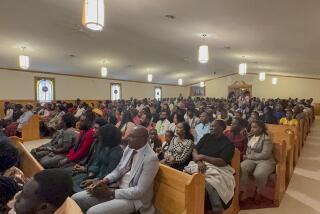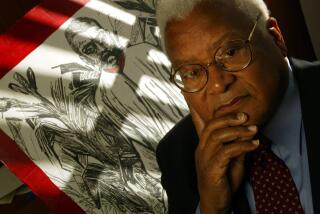Selma remembers
Selma, Ala.
The Rev. Frederick D. Reese was in a packed church, reading Scripture to the bruised and battered congregants, when the phone rang in the pastor’s study.
It was the evening of March 7, 1965 -- “Bloody Sunday” in Selma. Most of the 600 civil-rights marchers who had been attacked by Alabama state troopers that afternoon had retreated to hear Reese at the Brown Chapel AME Church, home of the movement in Selma.
When Reese picked up the phone, the voice on the other end said, “I understand you had a little trouble down there.” It was a fellow preacher, the Rev. Martin Luther King Jr., calling from Atlanta.
“Dr. King, that’s a huge understatement,” Reese remembers replying. He now chuckles as he tells the story, but back in those dark days of the mid-’60s, there was nothing funny about it.
“The state troopers had billy clubs in both hands. They literally went down the line, toppling the marchers over as if you were toppling bowling pins in a bowling alley,” the pastor, now 79, remembers in an interview.
King told Reese he was mobilizing ministers from around the country to make their way to Selma. They did, along with thousands of other people. What followed two weeks later was a turning point in black America’s struggle for equality: the voting-rights march from the Brown Chapel AME Church to the state Capitol, 50 miles away in Montgomery. Reese was in the front row of marchers, next to King and his wife, Coretta Scott King.
Today, the story of the march and what led up to it is vividly told at the Lowndes County Interpretive Center, a National Park Service facility about 20 miles east of Selma. It opened in 2006 on the site of one of the marchers’ overnight encampments.
“Selma pulled back the rug, and the dust came out,” Jean Jackson, a retired schoolteacher, says of that era. She adds that 40 years after the April 4, 1968, assassination of King in Memphis, Tenn., his dream has yet to be realized in Selma, where the population is roughly 19,000 and falling, and unemployment is 8.4% and rising.
“Dr. King would be terribly disappointed,” she says. “We are not doing as well, in some aspects, as we were before the movement. We have all the rights and privileges, but what good is it to have all the rights and privileges if [those things are] not going to feed us?”
But the era’s idealism still echoes, even if economic parity seems a long way off.
John Arthur, a Selma native who left Alabama when he was 17, recently returned to take a job at the interpretive center. “What brought me back was a sense of responsibility,” he says.
Back in 1965, Arthur was 5, too young to join any protests. But he recalls his older sisters leaving school one day to join a march for civil rights.
“I was at home. I remember it getting dark and my sisters weren’t there,” he says. “I remember my mom sitting my brother and me down and explaining that the girls had gone to jail.
“They had marched that day, they had been arrested and gone to jail. It was puzzling to me because she [Mom] wasn’t upset. That was the beginning of my understanding of responsibility.”
Lowndes County lies in the middle of Alabama’s Black Belt, named after the rich soil in which both corn and cotton are still grown. The exhibits at the interpretive center begin with the history of the African Americans who worked the fields -- first as slaves and later as sharecroppers -- long before any organized movement toward equality.
The short film that is shown, “Never Lose Sight of Freedom,” tells two stories -- that of the African Americans who struggled for their rights and that of the white supremacists who fought long and violently to hold on to power.
Visitors also walk through a gallery in which lifelike mannequins are used to re-create the march. One of them depicts a one-legged man from Michigan who made the entire journey on crutches.
Many moving first-person accounts of the march are also shared at the National Voting Rights Museum & Institute in downtown Selma.
From the museum, it’s just a two-minute walk to the Edmund Pettus Bridge, where police -- acting on orders from then-Gov. George Wallace -- turned back the marchers on Bloody Sunday.
Less than five months later, Congress enacted the Voting Rights Act of 1965, halting state-sanctioned efforts to keep Southern blacks from registering to vote. President Lyndon Johnson signed the bill into law on Aug. 6. King watched the president’s speech on TV from the Selma home of an old friend -- Jean Jackson.
City officials hope that increased tourism -- and the economic boost it would bring -- may be one of the answers to the area’s problems.
Reese heads a committee working to create the Dallas County Interpretive Center, similar to the one in neighboring Lowndes County, but with an emphasis on the history that was made in Selma.
“Our children must be taught how to appreciate the struggle that has taken place,” the pastor says.
“These interpretive centers and museums are important,” Jackson says. “What was done and what was accomplished not only benefited Selma, but it benefited the whole country.”
--
PLANNING THIS TRIP
Lowndes County Interpretive Center, 7001 U.S. Highway 80, Hayneville, Ala; (334) 877-1983, www.nps.gov/semo.
--
National Voting Rights Museum & Institute, 1012 Water Ave., Selma, Ala.; (334) 418-0800, www.selmavotingrightsmuseum.org.
More to Read
Sign up for Essential California
The most important California stories and recommendations in your inbox every morning.
You may occasionally receive promotional content from the Los Angeles Times.










